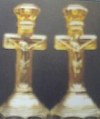Fenton - Part 2
FENTON GLASS - Part II
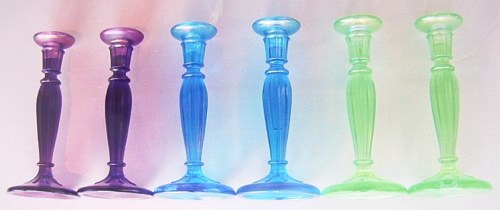 |
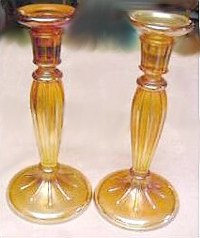 |
FENTON'S NUMBER 232-CANDLESTICKS
Gail Westphall had owned the Wisteria pair for some years, before locating the other two colors. Her article on the subject in 1999 states that to her way of thinking, these are the loveliest of Carnival Glass candlesticks. They are pictured among the stretch glass in FENTON GLASS-THE FIRST TWENTY-FIVE YEARS. They were produced circa 1925, have more pattern than the average candlestick, and none of the examples show much stretch effect at all, including the celeste/sapphire blue pair.
Even in speaking to a stretch glass collector over the years since Gail found the Wisteria pair, she has not been able to discover much specialized information about the pieces. Wisteria is the Fenton name for the light purple/amethyst coloration.
The marigold pair appeared on Ebay in late Sept. '04.
Deep ice green is the color of the other pair shown here. Intensity of the colors may be glorified by the thickness of the glass. This same pattern has been found in white, along with a velva rose shade. Stretch glass collectors sometimes match these candlesticks with the Dugan bowl called Adam's Rib to form a console set. Be prepared for a long search, should you decide you would like a pair of these #232's for your collection.
|
|
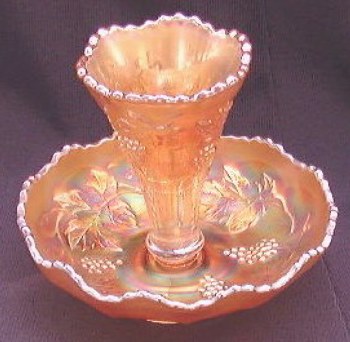
VINTAGE EPERGNE
This pattern is the Fenton answer to the need for a grape design in a competitive arena where Northwood and Imperial grape designs were extremely popular. This single lily epergne stands about 4 ¾” tall and can also be found in blue, amethyst, and an occasional green.
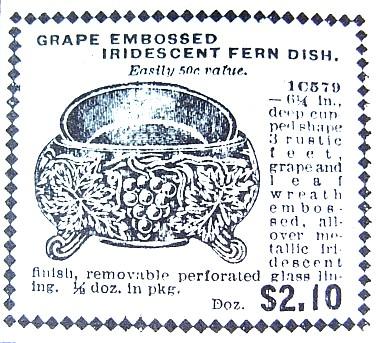
Feb. 1911 Butler Ad
Displays the Vintage Fernery and the original metal insert for protecting the glass when used for planting purposes. Considering the fact that Fenton began producing Carnival Glass patterns in 1907, we can appreciate the satisfactory “long run of acceptance” from all the patterns shown here. Now in their Centennial Year of business, Fenton patterns are still as desirable as in the beginning!
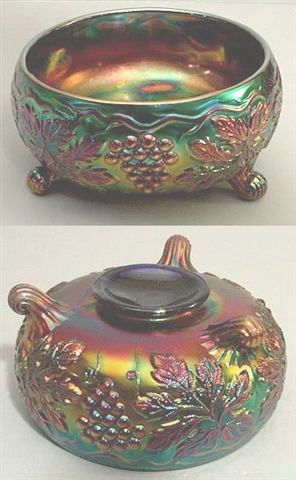
VINTAGE FERNERY
Vintage Fernery- another shape in this popular pattern will also be found in green, marigold, blue, and a rare red which is more on the dark or slag side than cherry color. An occasional reverse amberina and amber examples are known. The fernery stands 3 1/8” tall. Plates and bowls in 5-6” and 8-9” are to be admired in the pattern. A powder jar, nutbowl and bon bon are also available. A peach opal bon bon sold at auction for $140 in 2000.
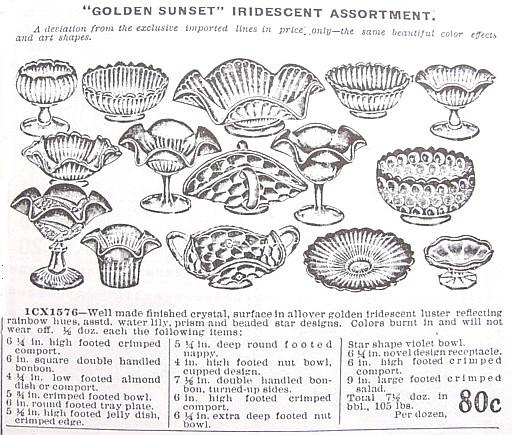
MID-SPRING-1909
This Butler Bros. Wholesale Ad displaying Fenton designs, confirms Finecut Flower to be in the realm of early Fenton production, along with the Min. Blackberry Compote, and the Small Rib pattern in several shapes.
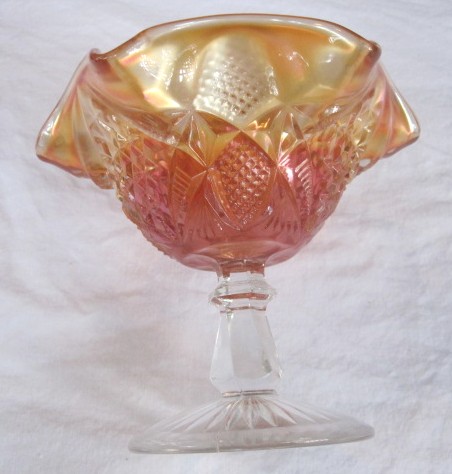
FINECUT FLOWER Courtesy Joe Brennan.
Finecut Flower is a pattern usually found in the marigold compote. However, in 1998, a green one surfaced and sold for $60, with another green example known; whereas the earlier marigold examples had been selling in the $45 range. Attribution had been granted to Imperial, but discovery of the compote amidst other Fenton products in a 1908-1909 Butler Bros. Wholesale Catalog, conclusively places it in the Fenton realm. These are iridized inside the bowl. The first few known were with clear stem and foot. We know of four such examples. The pictured compote, as you can see, is beautifully iridized inside and out, having marigold on stem and foot! We have seen another such as this. The Finecut Flower has six petals.
There are three mold lines visible on the foot. The compote stands 5 3/8” tall. The base is 3 1/8” in diameter. Hartung, in Vol. 4, p-26, shows Finecut Flower. She also shows Finecut Flower Variant in Vol. 7, p-48. Wm. Heacock's “The Glass Collector”, issue #3, Summer, 1982, p-16, offers an article surrounding the sameness and differences of these compotes. In a Jan. 1994 HOACGA Bulletin, Carl O. Burns reports that U.S. Glass produced a pattern called “Pennsylvania” in crystal, which may have been copied by Fenton as their Finecut Flower, since production years overlapped. Aside from that theory, the distinct possibility exists that if Fenton purchased that mold from U.S. Glass, production results indicate a distorted or badly worn mold.
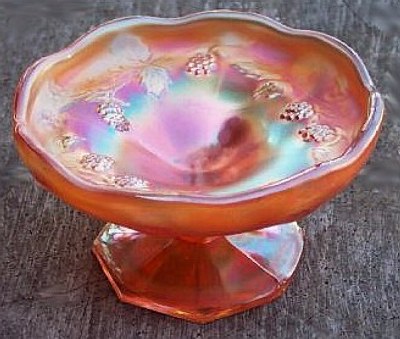
MINIATURE BLACKBERRY COMPOTE
Displayed in the accompanying Butler Bros. Ad, we know this pattern to have been among very early production elements. There is one known “orchid” compote, (so named by Frank M. Fenton, himself), along with marigold, blue, green, amethyst, white (very scarce). The compote was also produced minus the Blackberry interior pattern. Very rare are the few flattened shapes, creating a plate on the stem.
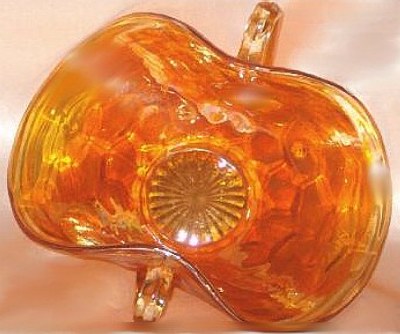
HONEYCOMB and CLOVER
Honeycomb and Clover is not an abundantly available bonbon. Usually seen in marigold, there are a few known in green. Pattern is on the exterior, with a plain, smooth interior. This same pattern is found exterior of the Feathered Serpent bowls.
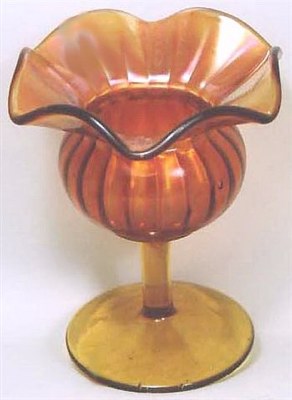
Amber SMALL RIB Whimsey Cuspidor
SMALL RIB Whimsey Cuspidor in amber base glass is an unusual “find”. Shaped from the mold shape-compote, the only time this special shaping occurs, is when the glass is so hot it will not hold its compote shape. It is possible that these might be found in an ice green base glass, or in clear base glass, as is used in many marigold iridescent pieces.
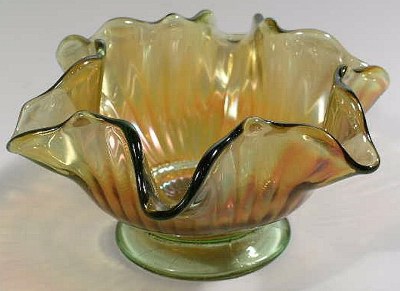
SMALL RIB Footed Bowl
This one has ice green base glass, with a marigold overspray.
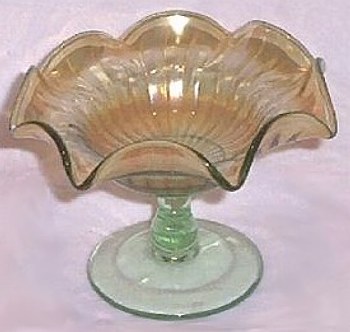
SMALL RIB Compote
The ice green base glass adds somewhat to the marigold overspray. Notice the two types of stems used in our photos, versus the same two available in the 1909 Butler Ad?
(This pattern is slurried over or omitted in most accounts written about Fenton production. We believe that since it was used in their very early years, it should take its rightful place among the many other ribbed offerings from various manufacturers.) It has its own distinction!
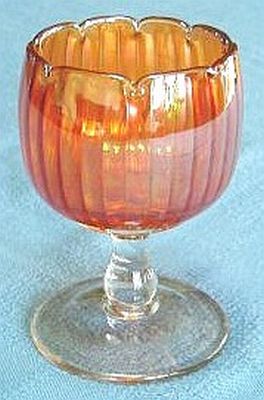
SMALL RIB Rosebowl
SMALL RIB Rosebowl type Compote displays the clear glass base. This shape is seen in the 1909 Butler Bros. Wholesale Ad. The slight “bulge” in the stem on this piece is seen on other Fenton compotes, as well.
Dean & Diane Fry - 1/05

What, then, is the truth about truth? A wise king wrote centuries ago, “The fear of the Lord is the beginning of knowledge” (Proverbs 1:7). We must recognize the relationship between God and truth. Without the help of the Holy Spirit and the instruction of God's Word, man will be ever “learning and never able to come to the knowledge of the truth” (2Timothy 3:7). When we acknowledge and obey His truth, however, we will be set free from spiritual ignorance and error. (John 8:32; 17:17). That's why we must be diligent in our study of the Bible (2 Timothy 2:15). It is the only book that tells us the truth about truth.---Vernon Grounds
*Study God's written Word to know Christ the living Word.
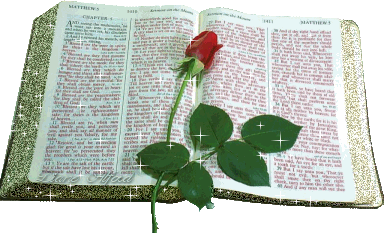
Should you care to contact the Frys, their email address is:
Search Our Sites
back to Carnival Glass 101
Our other sites you may enjoy:
Everything you EVER wanted to know about Indiana Glass
Great Reference for Newer Carnival Glass.
Complete Glassware Catalogs Available to Download
Questions? Comments? Suggestions? Broken Links? Corrections?
Your Friendly Webmaster is here to help!
